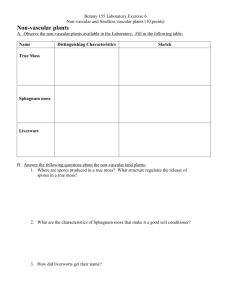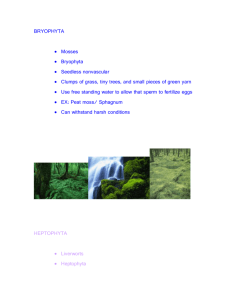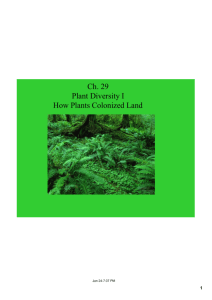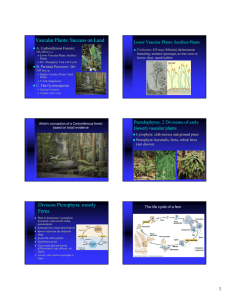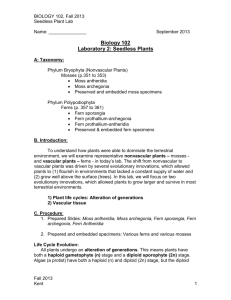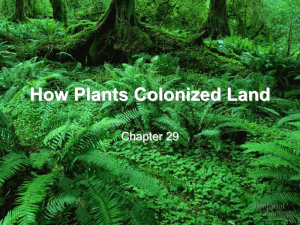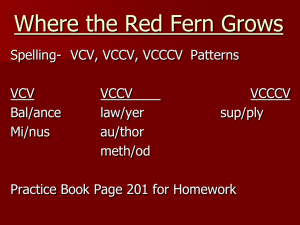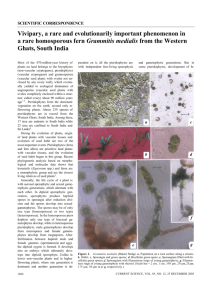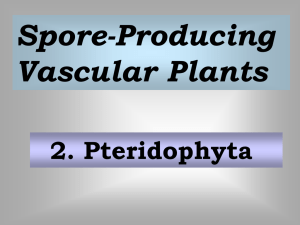ppt
advertisement
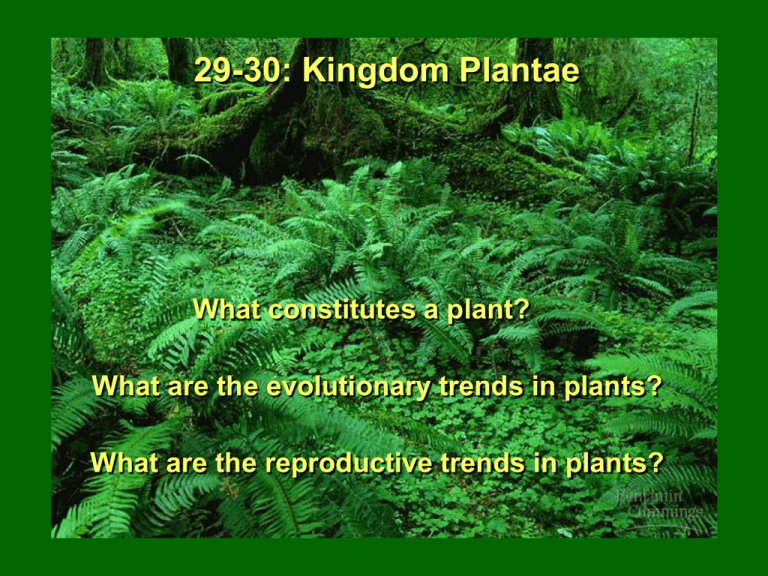
29-30: Kingdom Plantae What constitutes a plant? What are the evolutionary trends in plants? What are the reproductive trends in plants? The Netherlands What constitutes a plant? Plants are: Multicellular Eukaryotes Photosynthetic autotrophs Algae may also have these characteristics. Plants appear to have developed from algae. Other features that plants and algae have in common: Presence of chrolophyll b as an accessory pigment Cellulose cell walls Starch as storage product of surplus carbohydrates Plants occur both on land and in water. Algae only in the presence of water. 29.4 Where is the line dividing land plants from algae? Three possible plant kingdoms? Embryophytes: Plants with embryos Figure 29.7 Some highlights of plant evolution 1. Walled spores toughened by sporopollenin 2. Multicellular, dependent embryos 3. Apical meristems (root, shoot) 4. Presence of a waxy cuticle [See book p. 602-603] 29.5. Walled spores produced in sporangia. Spores are haploid reproductive cells that can grow into gametophytes (n) by mitosis. Sporopollenin makes the walls of spores very tough and protects them against dehydration Multicellular, dependent embryos Develop from zygotes that are retained within tissue from the female parent 29.5. Apical meristem Figure 35.18. Leaf anatomy (incl. waxy cuticle) Figure 3.3 Vascular tissue – support against gravity and transport system Phloem in plants Cambium Xylem: Water conducting cells Lignin: Hard material embedded in cellulose cell walls for structural support Figure 29.5 Alternation of generations: a generalized scheme A hypothetical mechanism for the origin of alternation of generations in the ancestor of plants Figure 29.7 Some highlights of plant evolution Table 29.1 Ten Phyla (Divisions) of Extant Plants (Embryophytes) Figure 29.3 Charophyceans The closest algal relatives of land plants Chara (top), Coleochaete orbicularis (bottom) 29.4 Chara Figure 29.7 Some highlights of plant evolution 29.9. Bryophytes Liverworts Hornworts Mosses Figure 29.8 The life cycle of a moss (Polytrichum) Figure 29.8 The life cycle of a moss (Polytrichum) gametophyte Moss life cycle sporophyte archegonium sporangium spores protonema Marchantia, a liverwort Gametangia: Archegonium of Marchantia (left), Anteridium of a hornwort (right) A moss sporangium with a “spore-shaker” tip Bryophytes Liverworts Hornworts Mosses Sphagnum, or peat moss: Peat bog in Oneida County, Wisconsin (top), close-up of Sphagnum (bottom left), Sphagnum "leaf" (bottom right) A peat moss bog in Norway Carbon reservoir may help stabilize global atmospheric CO2 29.11. More than 2000-year old bog mummy preserved in acid, oxygen poor Sphagnum wetlands 29.11. Peat, partially decayed organic material, harvested from peat moss (Sphagnum) wetlands. Decomposition is slow due to cold temperatures, acid conditions and little oxygen. Figure 29.7 Some highlights of plant evolution Xylem cells in angiosperms (see also Fig 35.10) Lignin Seedless Vascular plants - Ferns Figure 29.16 Lycophyta and Pterophyta. Artist’s conception of a Carboniferous forest based on fossil evidence (some 350 million yrs B.P.) 29.15. Lycophytes: club "moss" (top left), many are epiphytes Pterophytes: whisk fern (top right), horsetail (bottom left), fern (bottom right) strobulus Lycophyta Pterophyta Figure 29.13 The life cycle of a fern Figure 29.13 The life cycle of a fern Life cycle of a fern: mature fern Life cycle of a fern: sorus Life cycle of a fern: sporangium Life cycle of a fern: mature sporangium Life cycle of a fern: germinating Life cycle of a fern: gametophyte Life cycle of a fern: sporophytes 29.15. Lycophytes: club "moss" (top left) Pterophytes: whisk fern (top right), horsetail (bottom left), fern (bottom right) Lycophyta Pterophyta Figure 29.13 The life cycle of a fern Heterospory: The sporophyte has two types of sporangia that produce two types of spores, which develop into either female or male unisexual gametophytes. Spores: • Megaspore, developing into a female gametophyte, which will produce an egg • Microspore, developing into a smaller male gametophyte, which produces sperm Which of the following is TRUE of seedless vascular plants? A. They produce many spores, which are really the same as seeds. B. Seedless vascular plants are all heterosporous. C. Whole forests were dominated by large, vascular seedless plants more than 300 million years ago. D. The few seedless vascular plants still living are large and rare. E. None of the above are true. Vascular plants never form seeds. Chapter 29 –Review (p. 616) • • • Concept 29.1. Land plants evolved from green algae Concept 29.2. Mosses and other nonvascular plants have life cycles dominated by gametophytes Concept 29.3. Ferns and other seedless vascular plants were the first plants to grow tall
